Green and yellow are attention-grabbing colors associated with nature and the sun and symbolize harmony, joy, optimism, and growth.
That’s why birds that have green and yellow plumage have always been very popular.
Examples of green and yellow birds include the lesser goldfinch, budgerigar, golden conure, Wilson’s warbler, yellow-naped amazon, green jay, and many others.
Some of these stunning birds can be seen in the USA, including the budgerigar, green jay, and lesser goldfinch.
Here are their photos and some fun facts about them.
Table of Contents
Green And Yellow Birds
Yellow-headed Amazon
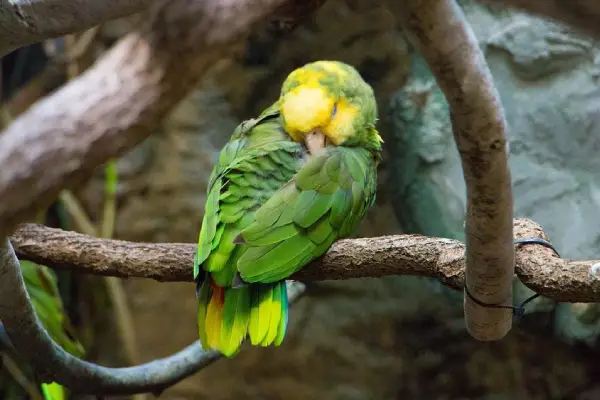
- Scientific name: Amazona oratrix
- Lifespan: up to 60 years
- Wingspan: n/a
Yellow-headed amazons are stocky birds, around 16 inches long, that can be found in mangrove forests or forests near water in Mexico and northern Central America.
Yellow-headed amazons have bright green plumage, yellow heads, yellow thighs, yellow outer tail feathers, and red shoulder patches.
Their striking colors and great singing ability make them very popular pets. People have been keeping them as companions since the 16th century, including pirates and aristocrats.
These green and yellow birds have calls that sound like “kyaa-aa-aaah” and “krra-aah-aa-ow,” while their young make “clucking” sounds when hungry.
Yellow-headed amazons can also learn to mimic opera singing.
In the wild, they are found in small groups, usually in pairs or even single. They are herbivores that mainly consume fruit, nuts, blossoms, berries, and leaf buds.
The International Union for Conservation of Nature (IUCN) lists them as endangered species, with their population dropping from 70,000 to around 7,000 birds in the last 20 years due to illegal trading.
They are also known as double yellow-headed parrots and yellow-headed parrots.
Budgerigar
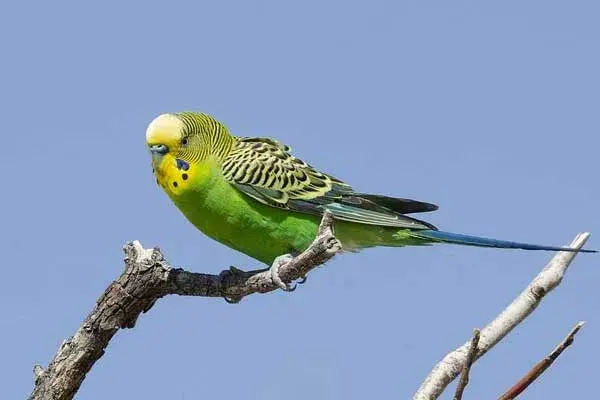
- Scientific name: Melopsittacus undulatus
- Lifespan: 3-6 years
- Wingspan: 12 in
Budgerigars are also known as common parakeets. These small seed-eating parrots with long tails are nicknamed budgies and are the third most popular pet in the world, right behind dogs and cats.
Budgerigars can have several shapes and colors; wild budgies are green and yellow, with black stripes and markings, and dark blue-green-black flight and tail feathers.
Outside of Australia, where they are native, budgerigars have a large population near St. Petersburg in west-central Florida. The consistent climate conditions in Florida significantly reduced their nomadic behavior so they are now year-round residents in the state.
- Read More: Other incredible green birds found in Florida
Budgies have a third eyelid, just like camels and llamas, that lubricates their eyes and keeps them clear of dirt and debris.
They are very intelligent birds that can count up to three and even learn words.
One budgerigar called Puck got into the 1995 Guinness Book of World Records as “the bird with the largest vocabulary in the world,” with over 1,700 words learned!
When the breeding season comes, female budgies can gain significant weight, up to 20% more than their usual. This is because they retain calcium during that period.
Guess I’m not overweight, I just retain calcium, just like the budgies, ha-ha.
Lesser Goldfinch
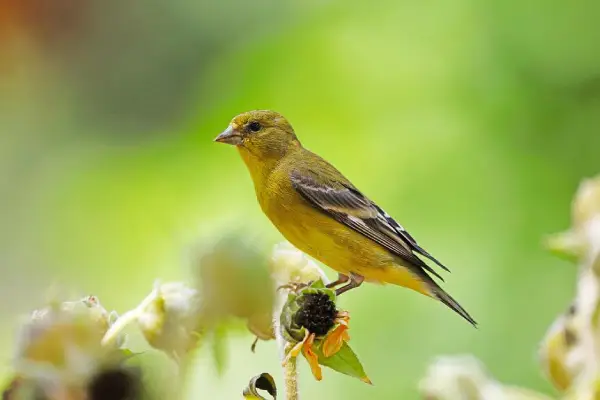
- Scientific name: Spinus psaltria
- Lifespan: up to 6 years
- Wingspan: 8 in
Lesser goldfinches are very small songbirds found in the southwestern US. They have long, pointed wings, and short, notched tails.
Male lesser goldfinches are bright yellow below and green or black on their backs. They also have black crowns and white patches in their wings. Females are olive-green below, dull yellow under, and have black wings with two whitish wing bars.
Identify lesser goldfinches by their song consisting of a series of melodious notes and trills, or their descending squeaky whistles and harsh “chig chig” calls emitted during flight.
They are commonly found in the open brushy country, open woods, wooded streams, and gardens of the western states, including California, Arizona, Nevada, Utah, New Mexico, and Colorado.
Lesser goldfinches are social birds that might mix with other songbirds, especially around bird feeders, creating groups of several hundred individuals.
They are herbivores that feed on seeds and grains.
Blue-naped Chlorophonia

- Scientific name: Chlorophonia cyanea
- Lifespan: n/a
- Wingspan: n/a
Blue-naped chlorophonias are small, plump birds with stout beaks that live in humid forests, gardens, and parks of South America.
Blue-naped chlorophonia males are mainly lime green with yellow underparts. They also have blue napes, rumps, and eye-rings. Females are duller and have greener bellies.
Blue-naped chlorophonias can be often seen in small flocks or pairs and heard by their whistles that consist of one to two notes.
They mostly forage in the canopy and feed on berries, leaves, nectar, and insect larvae.
Their breathtaking bright yellow and green coloration provides them with great camouflage in the tree canopy.
Golden Conure

- Scientific name: Guaruba guarouba
- Lifespan: 20-30 years
- Wingspan: 8.3 in
Golden conures are also known as golden parakeets. They are one of the prettiest on our list of green and yellow birds and can be identified by their large gray bills, brown eyes, and pink legs.
Golden conures have stunning brilliant yellow colors with dark green tips of their flight feathers.
These medium-sized parrots are native to the Amazon Basin in northern Brazil. During the non-breeding season, they are common around tall forests; during the breeding season, they leave forests and move to open areas on the forest edges.
Golden conures make great pets as they are easy to tame, quite affectionate, intelligent, and fun to watch. They are very active and also enjoy climbing, chewing, and playing with their owners.
In the wild, golden conures are considered endangered, with a population of around 10,000 birds remaining.
They are herbivores, preferring to feed on seeds, nuts, buds, flowers, and fruits, including crops such as corn and mangoes.
Wilson’s Warbler
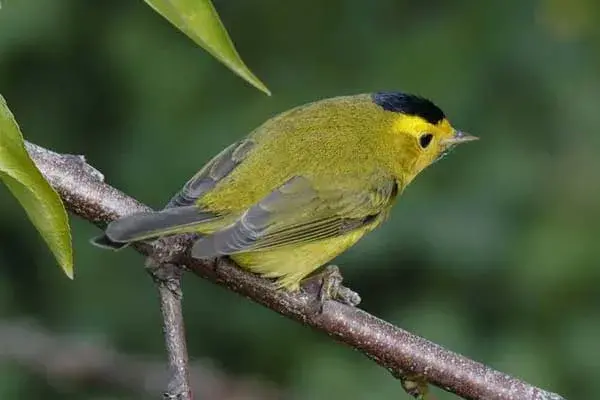
- Scientific name: Cardellina pusilla
- Lifespan: 6 years
- Wingspan: 5.5–6.7 in
Wilson’s warblers are small New World warblers with rounded wings and long slim tails. They breed in Canada and southern parts of the western United States, and winter in southern Texas, Mexico, and Central America.
Most of Wilson’s warblers that show up in Florida during fall and winter can be found in the southeastern portion of the state, between West Palm Beach and the everglades.
Wilson’s warblers are greenish above and yellow below; males also have small black caps on their heads.
Their song consists of a chattering series of loud descending notes, while their call is a flat “chuff“.
Source: Jonathon Jongsma, CC BY-SA 3.0, via Wikimedia Commons
Males look similar to the yellow warblers – the main difference is the distinct black cap on Wilson’s warblers, and yellow wing markings and yellow tail spots on yellow warblers.
These birds are named after American ornithologist Alexander Wilson.
Wilson’s warblers are insectivores that mainly consume insects, including beetles, bees, or caterpillars.
Yellow-naped Amazon
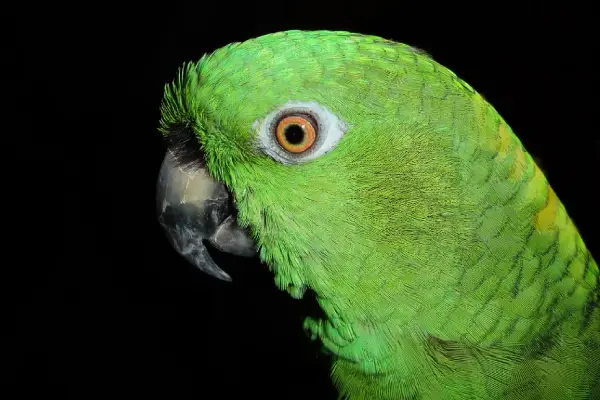
- Scientific name: Amazona auropalliata
- Lifespan: 20-30 years in the wild
- Wingspan: 8-8.5 in
Yellow-naped amazons are also known as yellow-naped parrots and golden-naped amazons. These large parrots are common on the Pacific coast of southern Mexico and Central America and have been marked as Critically Endangered by the IUCN.
Yellow-naped amazons are bright green and have yellow back parts of their necks. They also have orange eyes, dark gray bills, and dark gray feet.
These green and yellow parrots are common around dry forests and mangrove habitats.
Yellow-naped amazons are frugivores that feed on fruits, nuts, seeds, and berries. They forage in large groups but are usually found in small family groups or pairs.
They are cavity nesters, they use naturally occurring cavities to build their nests, and are monogamous birds; the pair will defend small breeding territories and sing in duet with their partners.
Yellow-naped amazons make popular pets as they look stunning and have great talking abilities. They might even learn to speak words with human-like clarity.
These social, loyal, affectionate, and intelligent birds can occasionally get loud and have aggressive periods when growing up when they often bite.
Great-tit

- Scientific name: Parus major
- Lifespan: 3 years
- Wingspan: 9.5 in
Commonly found in Europe, Asia, and Africa, great-tits are large songbirds that can be identified by their green and yellow colors, striking glossy black heads, white cheeks, and a distinctive two-syllable song.
They are usually found in woodland, parks, and gardens; these colorful birds nests in tree holes, but are just as happy to use nestboxes.
Males are particularly vocal throughout the year, with over 40 distinct notes recorded.
Their song usually consists of two repeating notes, one high and one low, that sound like “tea-cher, tea-tea-cher”. Their contact calls include soft “pit“, “spick“, or “chit” ‘ they also use loud “tink” as an alarm call.
Source: Oona Räisänen (Mysid), Public domain, via Wikimedia Commons
Great-tits are social birds that are active during the day and roost in flocks at night. They are omnivores that mostly feed on insects and seeds.
There are 15 subspecies of great-tits.
Painted Bunting

- Scientific name: Passerina ciris
- Lifespan: 5-10 years
- Wingspan: 8-9 in
Painted buntings are often described as “nonpareil” which means “without equal”. These colorful birds are native to North America.
They breed from late April to early August in the United States and can be found in Florida, different parts of Texas, Arkansas, Alabama, Oklahoma, and Louisiana.
Florida is the only US state that has a breeding and a wintering population of painted buntings.
Female painted buntings are bright yellow and green; males are a mix of blue, red, and green.
Despite being common in the USA, you might have trouble finding painted buntings as they prefer to stay in deep brush. The best time to see and hear them would be early in the morning when the males usually sing.
Their song consists of a series of short, musical phrases of thin, sweet, high-pitched notes. Painted buntings’ call is a soft “chip” or a “chit.”
Painted buntings are common around woods, fields, and feeders.
They might look cute and colorful, but painted buntings are aggressive birds. They are very territorial and will attack other males of their species.
Painted buntings are omnivores that mostly feed on seeds and insects.
White-winged Parakeet
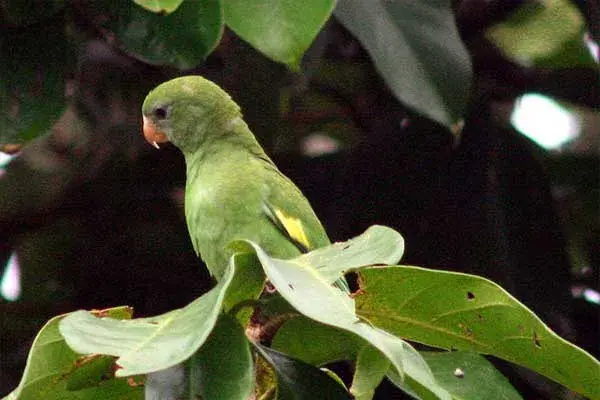
- Scientific name: Brotogeris versicolurus
- Lifespan: 10-15 years
- Wingspan: n/a
White-winged parakeets are also known as canary-winged parakeets. These small parrots have long, pointed tails and pinkish beaks and legs.
White-winged parakeets are mostly green in color and have trailing yellow edges on their folded wings. They are native to South America but can be also found in California and Florida in the United States.
After large numbers of these green birds escaped from captivity, white-winged parakeets became a common sight around southern Florida.
All parrots in Florida were released or escaped; the only parrot native to the USA is the Carolina parakeet which became extinct in 1918, due to hunting and habitat loss.
Quite affectionate towards their owners, white-winged parakeets will often ride around on shoulders or nest in the hair of their owners.
And unlike some other species, there are mostly quiet birds.
White-winged parakeets are herbivores that mainly feed on seeds and fruits in the wild, or vegetables, fresh fruits, and grains in captivity.
Green Jay
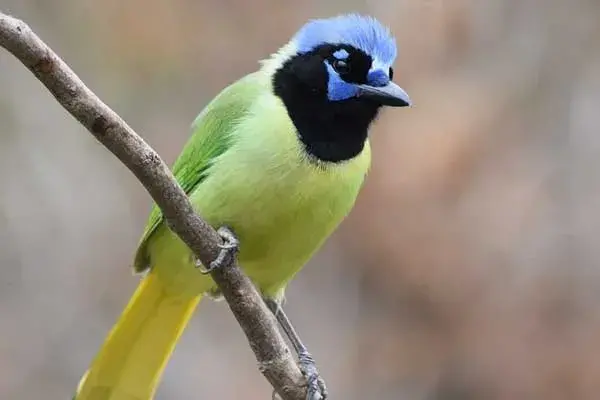
- Scientific name: Cyanocorax yncas
- Lifespan: 10-11 years
- Wingspan: 13.5-15 in
Green jays are widespread medium-sized jays. These colorful and noisy tropical birds are commonly found in North, Central, and South America. In the USA, green jays can be seen year-round in Southern Texas.
Green jays have green backs and yellow underparts. Their heads are black and blue; their eyebrows are very short and blue.
They are very intelligent birds that have been seen using sticks as tools to get insects from tree bark.
Green jays are omnivores that feed on different insects, small vertebrates, seeds, and fruit.
They got their scientific name “yncas” from the word “Inca” because the first descriptions of this species were based on birds from Peru, the place where Inca Empire rose.
A group of jays is called a “band”, “cast”, “party”, or “scold”.
Black-throated Green Warbler

- Scientific name: Setophaga virens
- Lifespan: up to 6 years
- Wingspan: 6.7-7.9 in
Black-throated green warblers are small songbirds that breed in coniferous and mixed forests of Eastern USA and Canada.
These green and yellow birds migrate to Mexico, Central America, and southern Florida to spend winter.
Black-throated green warblers are olive-green with yellow faces, and white underparts with black streaks on the flanks.
Males are different from females: they have black throats and upper chests while females have pale throats and black marks on their chests.
Black-throated green warblers can be also identified by their buzzed “zee-zee-zee-zooo-zeet” song and sharp “tsip” calls.
Source: G. McGrane, Public domain, via Wikimedia Commons
When the breeding season comes, males become very vocal; scientists once recorded one individual that sang over 460 songs in an hour.
These active birds are omnivores that mainly feed on insects and some berries.
Yellow-footed Green Pigeon
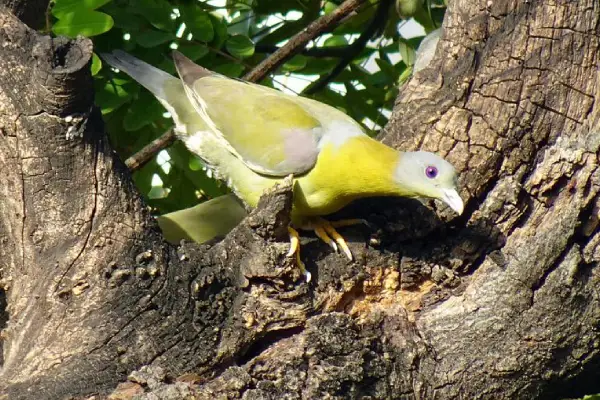
- Scientific name: Treron phoenicopterus
- Lifespan: n/a
- Wingspan: 7 in
Yellow-footed green pigeons are also known as yellow-legged green pigeons. They are commonly found in woodlands and gardens of Asia.
Yellow-footed green pigeons can be identified by their greenish-yellow color, blackish wings edged with yellow, small patches on shoulders, blue eyes, and bright yellow legs.
These birds are very social, forage in flocks, and have a diet consisting mainly of fruits, berries, and crops.
They are not very vocal and their call consists of a series of mellow, musical whistles.
Western Yellow Wagtail

- Scientific name: Motacilla flava
- Lifespan: n/a
- Wingspan: n/a
Western yellow wagtails are small songbirds that breed in temperate meadows, marshlands, and fields of Europe and Asia. They are around 6 inches long and can be recognized by their long tails.
Similar to other wagtails, western yellow wagtails will walk on the ground pumping their white-sided tails up and down.
Western yellow wagtails are olive-green above and yellow below; their head patterns vary from region to region, depending on subspecies.
They have a call that is described as a high-pitched “jeet“.
Source: Marie-Lan Taÿ Pamart, CC BY-SA 4.0, via Wikimedia Commons
Western yellow wagtails are insectivores that consume spiders and insects.
Yellow-collared Lovebird

- Scientific name: Agapornis personatus
- Lifespan: 10–20 years in captivity
- Wingspan: 3.7 in
Yellow-collared lovebirds are known under several names, including masked lovebirds and black-masked lovebirds. They are native to dry areas of Tanzania in East Africa.
Yellow-collared lovebirds are small parrots with green plumage, collars of yellow feathers between the head and body, and black heads. They also have bright red beaks and white rings around the eyes.
Males and females look alike.
These beautiful green and yellow birds can be often found in flocks; their calls include high-pitched squeals and scratchy “sveets“.
Source: ZooFari, CC BY-SA 3.0, via Wikimedia Commons
Yellow-collared lovebirds breed from March to July in the wild and are among the rare parrot species that make nests instead of using existing cavities.
These birds are monogamous and pair for life early. Yellow-collared lovebirds can be often seen grooming their partners and other members of their flock.
They are herbivores that mainly consume fruits, plants, seeds, and buds.
Yellow-crowned Amazon

- Scientific name: Amazona ochrocephala
- Lifespan: 20-30 years in the wild
- Wingspan: 8.5 in
Yellow-crowned amazons are parrots native to the Amazon Basin in South America. Some scientists refer to yellow-headed and yellow-naped amazons as subspecies of yellow-crowned amazons.
Yellow-crowned amazons are easy to recognize in the wild due to their bright green color and distinct yellow patches on their heads similar to crowns, hence the name.
They also have dark gray beaks and feet and blue and red patches on the wings and tails.
Yellow-crowned amazons are commonly found in pairs or groups of up to 30 individuals around rainforests, woodlands, mangroves, and savannas.
They are omnivores that feed on fruits, nuts, seeds, and berries. These parrots nest in tree hollows and lay two to three eggs.
Similar to other species of amazon parrots, yellow-crowned ones are very popular due to their energetic nature, affection, vocal ability, and intelligence.
European Greenfinch
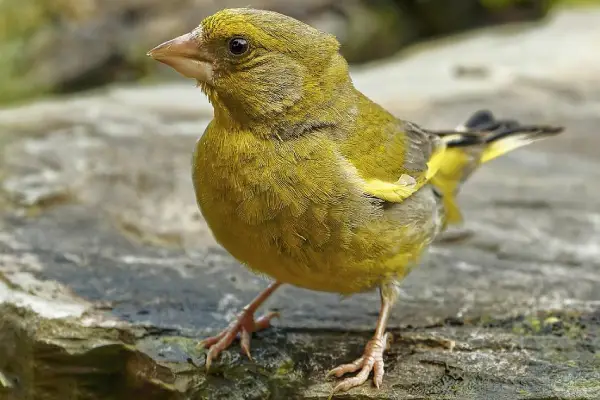
- Scientific name: Chloris chloris
- Lifespan: 2-3 years
- Wingspan: 9.6-10.8 in
European greenfinches are small songbirds found in Europe, North Africa, and Southwest Asia. They are sparrow-sized birds, around 6 inches long.
European goldfinches have green plumage with yellow wings and tails. They also have thick and conical beaks. Females are slightly duller than males.
They can be identified by their song consisting of lots of trilling twitters mixed with wheezes.
European greenfinches breed in woodland edges and gardens, build their nests in trees and bushes, and lay from three to six white eggs with spots.
They are omnivores and feed on seeds and berries.
Superb Parrot
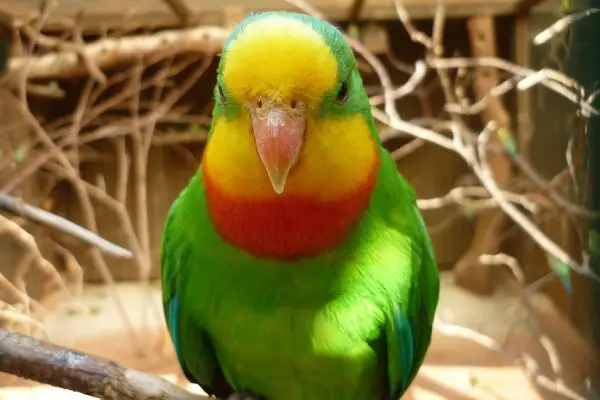
- Scientific name: Polytelis swainsonii
- Lifespan: 10-15 years
- Wingspan: 16 in
Superb parrots are medium-sized bright green parrots with yellow necks and yellow-orange eyes.
Males have reddish bands on their upper chests and bright yellow faces and throats while females have pale blue-green faces, greyish-green throats, and orange thighs.
Superb parrots’ call is a repeated wavering chatter.
These parrots are endemic to Australia and can be found in the New South Wales region.
They are herbivores that feed on the ground and consume flowers, fruits, nectar, and pollen.
Superb parrots breed between September and January and nest in small colonies.
Hooded Warbler

- Scientific name: Setophaga citrina
- Lifespan: 8 years
- Wingspan: 6.9 in
Hooded warblers are small birds and medium-sized warblers that breed in eastern parts of the United States. They are migratory birds that winter in Central America.
They got named after the distinctive black hoods on their heads.
Male hooded warblers can be identified by their olive-green upperparts, yellow underparts, yellow foreheads, and yellow cheeks. Females are similarly olive-green above and yellow below; they only have the shape of the black hoods found in males.
Listen for their song consisting of a series of musical notes that resemble “wheeta wheeta whee-tee-oh” and the loud “chip” or “chink” calls.
Source: G. McGrane, Public domain, via Wikimedia Commons
Hooded warblers are insectivores that forage in low vegetation. They feed on caterpillars, moths, grasshoppers, beetles, flies, and small spiders.
Hooded warblers might feed on their prey by “hawking,” snatching them mid-flight.
Brown-headed cowbirds, parasitic small black birds, might occasionally lay eggs in the warblers’ nests for them to raise their young. This behavior is known as brood parasitism.
Read More: List of North Carolina’s Songbirds
Gouldian Finch
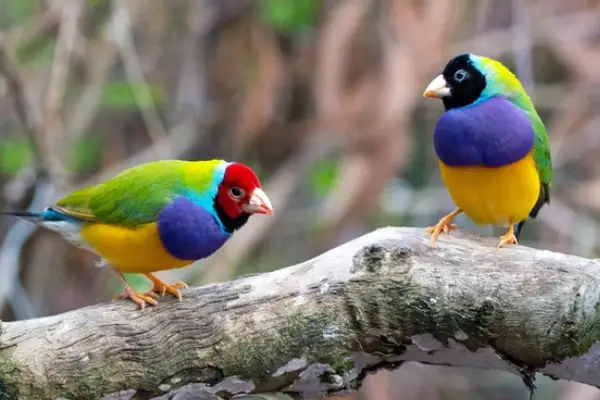
- Scientific name: Chloebia gouldiae
- Lifespan: 5-8 years
- Wingspan: 5.5 in
These extremely attractive and strikingly colorful birds are native to the grasslands of Australia.
Gouldian finches are green, yellow, black, and red; females tend to be less bright. Males also have purple chests while females have pale purple ones.
These birds can have three different colors on their faces: the most common one is black (70%), red (20-30%), and yellow (around 1%).
They are also known as Gould’s finches, rainbow finches, and Lady Gouldian finches (after Elizabeth Gould, the wife of a famous 19th-century British ornithologist John Gould).
Some estimates claim a population of around 2,500 Gouldian finches in the wild, mainly in the Northern Territory and Kimberley regions of Western Australia.
They love to form large flocks with long-tailed finches and masked finches during the non-breeding season, making groups of over a thousand individuals.
Gouldian finches are seed eaters and need to consume around a third of their body weight each day; they weigh around 0.5 oz.
Read More: Examples of tiny green birds
Summary
This concludes our list of green and yellow birds.
Examples include several types of parrots, warblers, finches, etc.
Hopefully next time you see these birds, you will recognize any of them with ease!
And if you enjoyed our article, here are other popular reads on birds: Examples of pink birds found in Florida and examples of blue and red birds found throughout the world